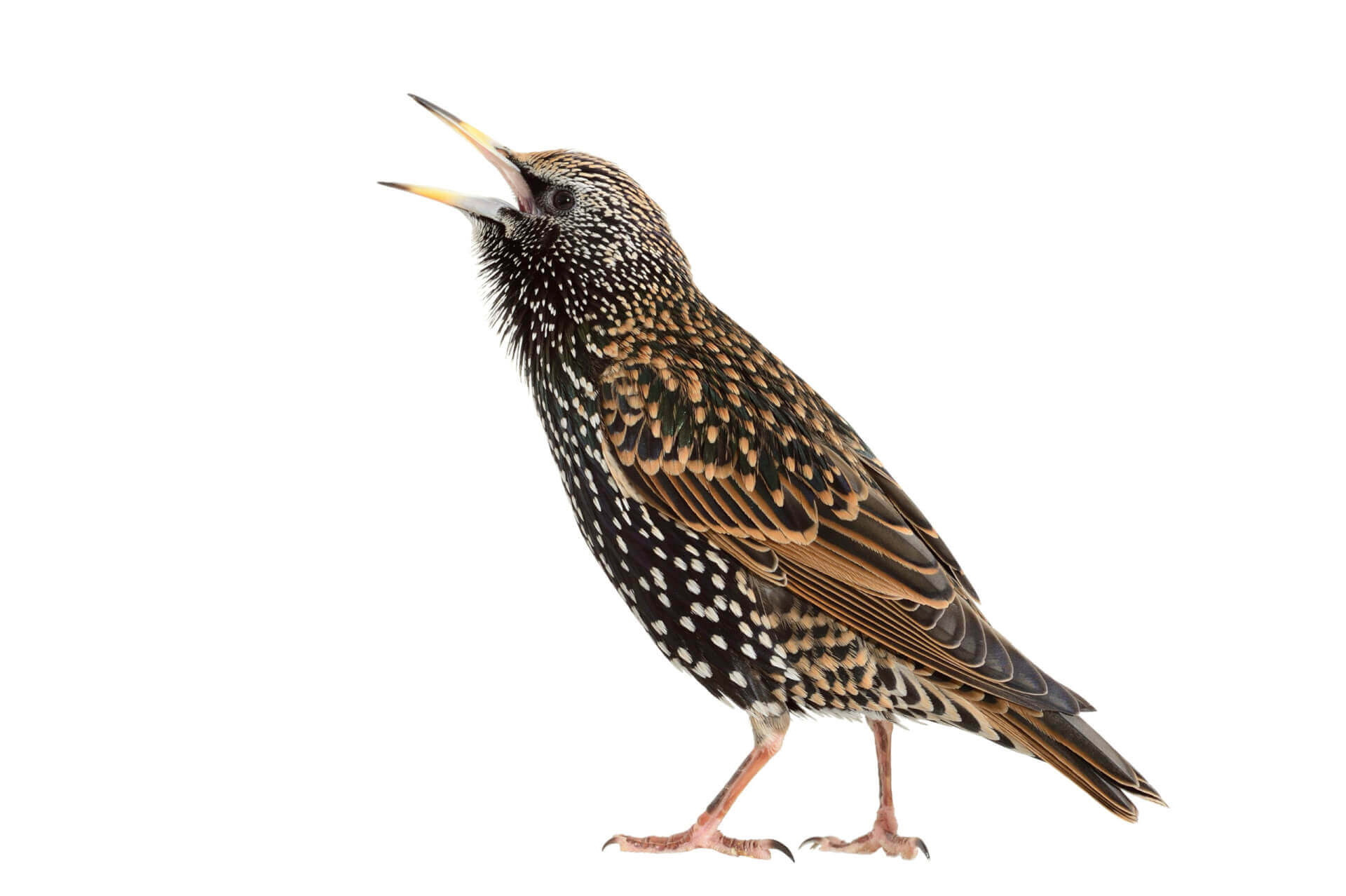Starling Facts & Information
Everything you need to know about starlings
what do Starlings look like

Male and female starlings look similar. Both are glossy black with purplish and greenish iridescence on the head, back, and breast. Males have yellow bills in spring. Juveniles have grayish brown plumage, and their bills are brownish in color. They eat tons of gypsy moths and caterpillars, flies and fly larvae, and many other obnoxious insects.
Male starlings are gifted nest decorators and fumigators and mated pairs are usually monogamous and are devoted parents. Starlings are also talented mimics—they can reproduce the sounds of humans, other birds, and inanimate objects. Starlings are known for their gracefully synchronized aerial murmuration dances. Their iridescent feathers shimmer and sparkle with star-like dots, so there is no doubting their beauty. You can admire the majesty of their “star”-covered, gleaming feathers, despite their gluttony and aggressive nature. You don’t want to hurt the birds, which is why you shouldn’t be looking for a bird exterminator. You just want them to move along – that’s what our humane bird control does.Not the bird you have?
Male starlings are gifted nest decorators and fumigators and mated pairs are usually monogamous and are devoted parents. Starlings are also talented mimics—they can reproduce the sounds of humans, other birds, and inanimate objects. Starlings are known for their gracefully synchronized aerial murmuration dances. Their iridescent feathers shimmer and sparkle with star-like dots, so there is no doubting their beauty. You can admire the majesty of their “star”-covered, gleaming feathers, despite their gluttony and aggressive nature. You don’t want to hurt the birds, which is why you shouldn’t be looking for a bird exterminator. You just want them to move along – that’s what our humane bird control does.Not the bird you have?
where do starlings live
Starlings form communal roosts which can be home to 10,000 or more birds. As they migrate during the winter, flock populations can grow into the hundreds of thousands. Their preferred nesting sites are tall trees or buildings with cavities where they can readily build nests using dead grasses and fresh vegetation rich in chemicals that act as fumigants. Starlings will maintain the insulating properties of the nest until their chicks are feathered, at which point the nests begin to resemble pest-ridden compost. Females will lay as many as seven eggs in one brood. Starling eggs hatch after less than two weeks of incubation and young starlings leave the nest within three weeks of birth.
Now considered one of the worst nuisance birds in this country, Old World starlings were purposely introduced to Central Park, New York City in 1890 by a well-meaning but misguided man. The original 60 pairs that were released rapidly multiplied. Soon after, the American starling population exploded, and the species spread rapidly throughout the entire U.S. and much of Canada. Starlings are known to compete with, displace, and kill many native birds and their young. Starlings are now considered an invasive species and are despised by ecologists, birder enthusiasts, and business owners alike. So, yeah. They live here now.
Now considered one of the worst nuisance birds in this country, Old World starlings were purposely introduced to Central Park, New York City in 1890 by a well-meaning but misguided man. The original 60 pairs that were released rapidly multiplied. Soon after, the American starling population exploded, and the species spread rapidly throughout the entire U.S. and much of Canada. Starlings are known to compete with, displace, and kill many native birds and their young. Starlings are now considered an invasive species and are despised by ecologists, birder enthusiasts, and business owners alike. So, yeah. They live here now.
how did i get starlings
Starlings like to nest on tall trees or buildings with cavities. They then build nests with dead grasses and fresh vegetation. If you are near trees like this or having these types of cavities in your home or building, then starlings will be happy to take up shop. Starlings love to eat wild and cultivated fruits such as berries and cherries, as well as large quantities of feed from livestock farms. So if you have their preferred foods they will be around and they will definitely bring their friends. They are intelligent birds who engage in a variety of unique behaviors that allow them to thrive in their environments.
what Problems do starlings cause
Starlings are known to compete with, displace, and kill many native birds and their young. Starlings are considered an invasive species and are despised by ecologists, birder enthusiasts, business owners, and homeowners alike. Their aggressive nature also applies to the way they nest which can do considerable damage to homes, businesses and free-standing structures like garages, porches, sheds, etc. They dig out cavities to build nests from the smallest cracks and crevices to start. Starlings peck and slash to create the cavities, causing considerable damage and compromising structural integrity. Their corrosive droppings can damage all kinds of objects and surfaces which is why you need bird treatment that will repel birds like these.
how can i prevent starlings
Starlings will try to dominate any area they occupy and compete with native birds for food and cavity-nesting opportunities. So, while you may like having a bird feeder for the sweeter birdies out there around your home or business, it will also attract the nasty starling. There are plenty of humane techniques that can be used by a professional in the bird mitigation industry that can keep these destructive birds away from your business or home.
WHY WESTERN for starling control
We’re passionate about controlling birds around your home or business because we live and work here – it’s our neighborhood, too. With our almost 100 years of experience keeping homes and businesses in Connecticut, Delaware, New Jersey, New York, and Pennsylvania safe from pests, Western has the experience you can trust.
100% Satisfaction Guarantee
24-Hour Guaranteed Response
Board Certified Entomologists
Need help with starlings?
GET MY QUOTE
